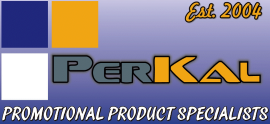
A companies logo is a powerful thing. For example, say the words “golden arches” and just about everyone will think of McDonald’s. The “red bullseye” is strongly associated with retailer Target. Getting customers to remember your brand starts with an effective logo design.
We at Perkal know a little bit about what makes a good logo. It’s quite literally our middle name! A great logo is kind of like beauty: it’s in the eye of the beholder. However, since we are in the logo business, we wanted to establish a few basic guidelines to help you with that one-of-a-kind design.
Factors such as uniqueness, adaptability, aspect ratio, scalability, and a logo’s ability to work without color are all things to consider when designing a logo for your company.
The Purpose of a Logo
Your logo is often times the first impression people will have of your company. Whether it’s on the sign outside your business, on a business card, or on your website, it’s the calling card that represents who you are as a business. It’s most likely what a customer will remember after they’ve left.
A great logo can be printed on business cards, brochures, newsletters, letterhead, T-shirts, umbrellas, or personalized pens and never lose its message to customers.
A good logo conveys some kind of metaphor as a printed design and effectively communicates the intended message or image. This requires an eye for images, color, text, style, and geometric proportion. A logo that is representative of a company, organization, event, or campaign will best deliver the desired message.
The Originality of a Logo
Being unique doesn’t mean your logo has to say what your company does or offers. Starbucks’ logo isn’t a coffee bean, and if you didn’t know that Apple was a computer/technology company, you might think they owned several apple orchards. Yet both companies’ logos are immediately recognizable even without any wording.
A logo is one of the most effective marketing tools in the advertising world, but you can use it even more effectively by following some basic rules. Do not copy a popular logo from a well-known company, and avoid making your design similar to another logo with the hope of getting more attention. Copying another company’s work will actually have an adverse effect on your business!
The Simplicity of a Logo
Powerful doesn’t have to mean complicated. The best logo designs are all very simple, which makes them the most recognizable. Yet a simple design isn’t always the easiest to achieve.
Easy Does It!
Words aren’t necessary in a logo, but they may be used in conjunction with the image. It’s important to keep in mind that a logo should be able to stand on its own. It should be easy to describe to someone who’s never heard of your brand before.
A logo should also be distinctive enough to be immediately recognizable. This may sound difficult; simple and distinctive don’t always come together easily. However, if you remember to keep it simple first, you’ll eliminate a lot of the stress of coming up with a great design.
Additionally, having a simple design means it will be easy to alter the size or color, which is key when printing your logo on promotional products! Since most products will cost you more money for each additional color, being able to effectively reprint your logo in one color is a huge asset.
The Size and Shape of a Logo
Speaking of printing a logo, let’s discuss aspect ratio. Aspect ratio is the space required to reproduce your logo. It is also called the footprint, and it’s something that is easily overlooked when first designing a logo.
Horizontal aspect ratios are great for web banners, while circle logos are very strong visually. These are just a couple of factors to consider while designing your own logo.
If you’re not all artistic, consider hiring an artist or graphic designer to help you with your vision. Graphic artists have many resources to simplify art, enhance images, and rescale designs. This process was once done by hand-drafting designs that were later reproduced on art paper. Today, logos are generated by computer software that electronically accesses shapes, artwork, and colors.
It is crucial that the printed final version reproduce an equal quality logo image, regardless of size. This makes the logo reproducible while maintaining its integrity.
The Evolution of a Logo
It’s also important to know that once you’ve come up with your logo it doesn’t hurt to go back and revisit it from time to time. Even powerhouse tech companies aren’t immune to the change. In mid-2015 Google unveiled a brand new logo. It was the first redesign the logo had undergone in 16 years. The logo also morphs into a series of dots when you search for something on its website or on a mobile device.
Still, it doesn’t take away from the Google brand. If you see that multi-colored “G,” with or without the serif style, you’d know it was the search engine. That’s how you know a logo is effective and works for your brand.
Above all, creating a great logo will only advance and grow your business. Simple, clean, and strong design are all key factors in the designing process. Just remember to keep experimenting! Don’t be afraid to come up with several different designs and go with the one that you and your team like the best.













